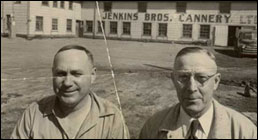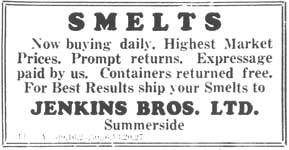In August 1942, the firm approached the town for municipal land at the east end on which to construct a new factory. There was reference at a town council meeting to the request being "backed by a prominent Montreal canning concern." The town officials decided not to set the precedent of offering town land and encouraged the Jenkins to purchase suitable property.
The opportunity came when they were able to buy land from the Noonan estate just east of the dehydration plant. The brothers announced in May 1943 that they planned to start a new cannery building that summer. The firm had acquired contracts to produce products for the armed forces and those of the Allies.
The official opening of the new factory took place in January 1944. The modern plant faced Water Street with its main entrance off newly created Noonan Street. The back of the L-shaped building was close to the tracks for easy loading and unloading of railway cars. It was a 2-½-storey wooden-frame structure designed by the Jenkins and built by M.F. Schurman Ltd. Other local firms that had contracts were R. T. Holman Ltd., and R. T. Morrison & Sons.
There were offices for the President W. E. Jenkins, the Vice-President J. B. Jenkins and for Frank Cameron, secretary-treasurer of the company. There was also an office in the building for Dr. R. S. MacDonald, a representative of the federal Dept of Agriculture. Under national regulations established in the fall of 1943, federal government inspectors had begun to oversee grading, and veterinarians inspected chicken carcasses. The meat was packed as Grade A or Grade B into 7-ounce or 1-pound cans with salt and gelatin. It was shipped as far west as Alberta for the domestic market. Canned chicken was also used on hospital ships.
| Related Articles | Related Images | Related Memories | Related Websites | Inflation Calculator |
| Home Page | Site Map | Contact Us | Wyatt Heritage Properties |






